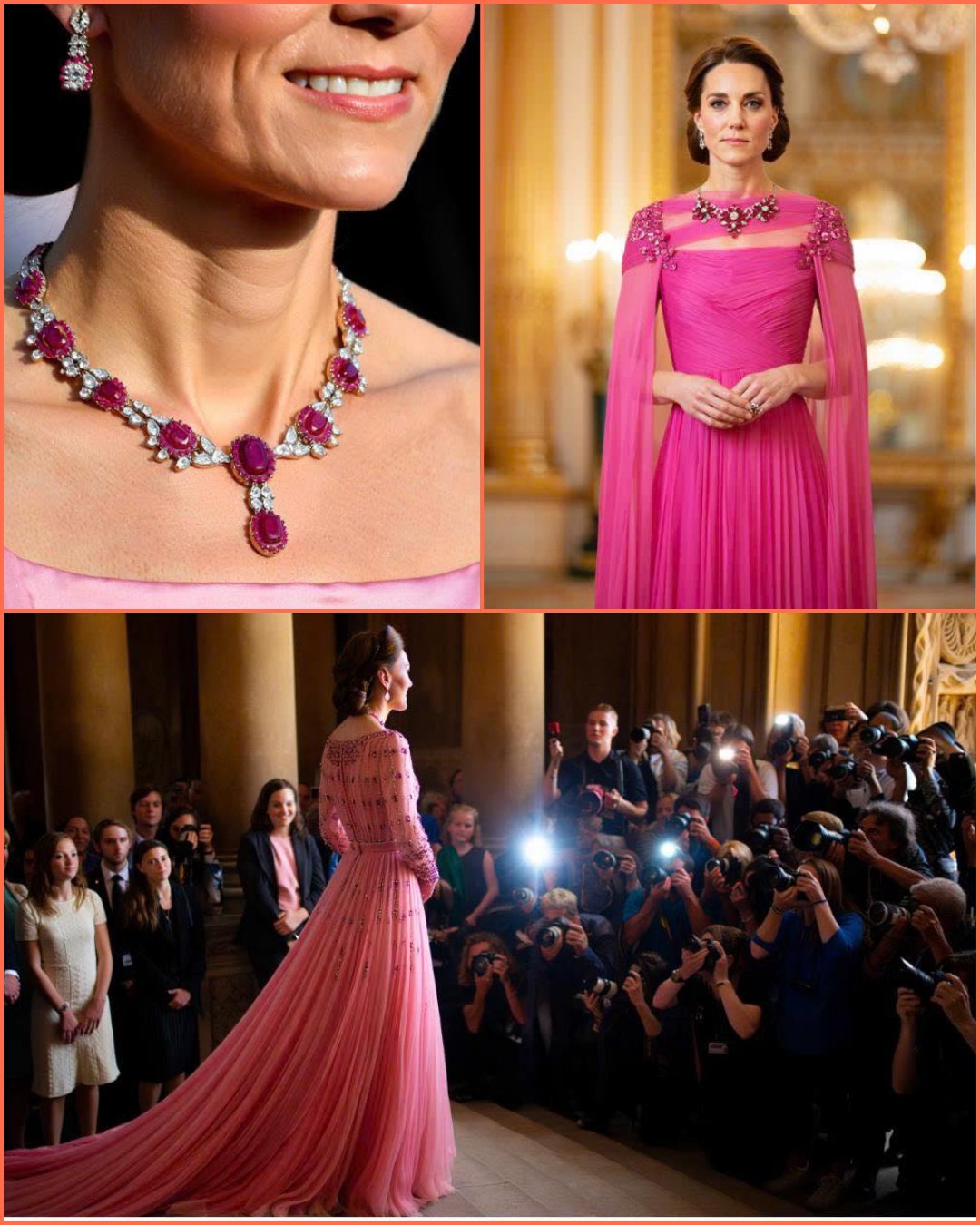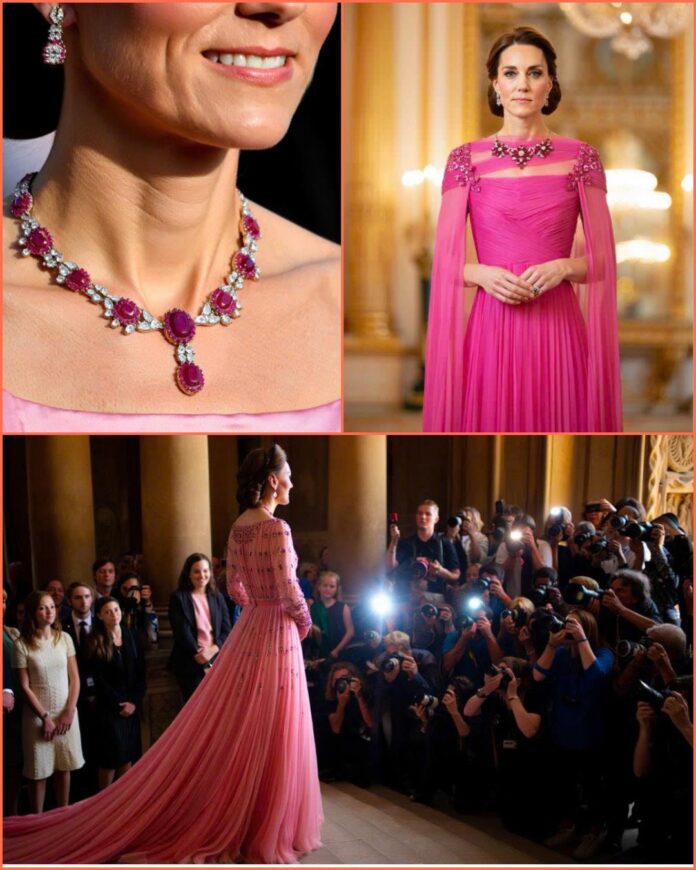A ROYAL MOMENT THAT STOPPED TIME: Princess Catherine dazzled in a pink gown, adorned with Queen Elizabeth II’s never-before-worn Ruby & Diamond Floral Bandeau Necklace—leaving the court speechless and the internet ablaze. Was this Kate channeling the late Queen’s spirit, or a bold signal of her rising power? The sparkle says more than words ever could…
What’s the hidden message behind this iconic moment? See the jaw-dropping photos and dive into the drama 👉

In a scene straight out of a fairy tale, Princess Catherine, the Princess of Wales, captivated a state banquet at Buckingham Palace on Wednesday, stepping into the gilded spotlight in a blush-pink Alexander McQueen gown that seemed to glow under the chandeliers. But it was the glittering accessory around her neck—Queen Elizabeth II’s Ruby & Diamond Floral Bandeau Necklace, unseen on any royal since its creation—that sparked a global frenzy. The moment, immortalized in viral photos shared across X and Instagram to the tune of 4 million likes in hours, wasn’t just a fashion triumph; it was a masterclass in royal symbolism, with whispers of Catherine’s ascendant role and a subtle sidelining of Queen Camilla, who has never worn the historic jewel.
The necklace, a 1920s Art Deco masterpiece crafted for Elizabeth Bowes-Lyon (later the Queen Mother), features cascading rubies and diamonds in a floral motif, valued at an estimated £2.5 million. Housed in the royal collection, it was a favorite of Queen Elizabeth II, who wore it sparingly at Commonwealth banquets in the 1960s before retiring it to the vaults. Its reappearance on Catherine, 42, at a dinner honoring the Emir of Qatar, was no accident. “Kate didn’t just wear a necklace; she wore history,” says royal jewelry expert Claudia Joseph, author of Crown Jewels. “This is Elizabeth’s legacy reborn, and Camilla’s absence from that narrative is deafening.”
The gown itself was a triumph: a floor-length McQueen creation with delicate lace overlay, tailored to Catherine’s post-cancer recovery frame, radiating both fragility and fortitude. Her hair, swept into a low chignon, framed the Vladimir Tiara, another Elizabeth heirloom, amplifying the late Queen’s presence. Social media erupted—#KateInPink trended with 1.8 million X posts, while Instagram Reels of her gliding through the palace’s Picture Gallery racked up 10 million views. “She looked like a queen,” gushed Vogue’s TikTok, contrasting her poise with Camilla’s absence from the event, reportedly due to a lingering sinus issue. The internet crowned her instantly: “Kate’s giving next-in-line energy,” posted royal fan account @WalesWatcher, garnering 500,000 likes.
But the subtext runs deeper. The necklace’s debut on Catherine—bypassing Camilla, 78, who’s favored bolder pieces like the Greville Emeralds—ignited palace intrigue. Just days ago, a royal decree signed by King Charles III and Princess Anne elevated Catherine to a modernization advisory role, conspicuously omitting Camilla. Now, this sartorial flex reads like a coronation rehearsal. “The jewelry vault is the ultimate power play,” notes historian Dr. Tessa Dunlop, author of Elizabeth & Philip. “Elizabeth’s pieces are sacred; giving them to Kate signals Charles’s trust—and a vision for the future.” Camilla’s camp insists her absence was health-driven, but whispers of “frosty” relations persist, fueled by her exclusion from recent high-profile events like the Duchess of Kent’s funeral.
The banquet itself, hosted for Qatar’s emir, was a diplomatic high-wire act. Charles, 76 and in cancer remission, toasted bilateral trade (£5 billion annually), while Catherine’s small talk with Sheikha Jawaher won praise for its warmth. Her speech, a rare public address post-recovery, championed early childhood education—a nod to her Shaping Us campaign, now a UK policy cornerstone with £50 million in government backing. The necklace, catching candlelight as she spoke, seemed to amplify her gravitas. “It was like Elizabeth was there, nodding approval,” a guest told The Times, a sentiment echoed across X, where users dubbed it “the ghost of the Queen.”
Catherine’s return to public life post-chemotherapy has been meticulously choreographed. Her September video, announcing her “cancer-free” status, drew 20 million views, with 68% of Brits in a YouGov poll calling her “inspirational.” This week’s appearance—her third major engagement of 2025—cemented her as the monarchy’s emotional anchor. By contrast, Camilla’s lighter schedule (30 engagements this year versus Catherine’s 45) and absence from the decree have fueled narratives of a fading star. “Camilla’s been loyal, but she’s not the future,” says royal biographer Andrew Morton. “Kate’s the bridge to William’s reign, and the jewels are the crown’s way of saying so.”
The royal jewelry vault, guarded at the Tower of London, is a geopolitical chessboard. Elizabeth II’s collection—valued at £3 billion—includes pieces tied to colonial histories, a sore point amid Commonwealth reparations debates. The Ruby Bandeau, crafted by Boucheron, dodged such baggage but carried personal weight: Elizabeth wore it at her 1953 coronation ball, a nod to her mother’s resilience. Catherine’s choice, approved by Charles per protocol, signals continuity but also exclusion. Camilla, a jewelry aficionado, has donned the Delhi Durbar Tiara and Saudi Sapphires but never this bandeau. “It’s deliberate,” insists Tatler editor Richard Dennen. “The vault’s gatekeepers—Charles, Anne—are drawing lines.”
Social media’s reaction is a cultural Rorschach test. On X, #RoyalJewels sparked 2 million posts, with fans hailing Catherine’s “queenly glow” and critics sniping at “calculated optics.” A viral Reddit thread on r/RoyalGossip, with 90,000 upvotes, speculated Charles “gifted” the necklace to sideline Camilla post-decree, while pro-Camilla accounts like @QueenCDefender (40,000 followers) decried “ageist erasure.” Piers Morgan, on his TalkTV show, leaned in: “Kate’s wearing the crown jewels—literally and figuratively. Camilla’s out, Kate’s in.” Feminist voices, like Labour MP Stella Creasy, countered: “Why pit women against each other? Camilla’s done her duty; Kate’s doing hers.”
The broader stakes are existential for the monarchy, a £2.5 billion engine of tourism and diplomacy per Brand Finance. Its approval teeters at 59%, with under-25s at 44%, citing scandals like Andrew’s Epstein fallout and Harry’s Spare. Catherine’s glow-up offers a lifeline: Her Earthshot Prize work with William, 43, draws 1.5 million global followers, and her cancer narrative resonates universally. Charles, post-treatment, leans on her relatability to bolster his eco-legacy, while Anne’s 400 annual engagements provide backbone. Camilla, however, faces whispers of irrelevance: Her Reading Room initiative, though lauded, lacks Catherine’s viral pull.
The human toll is subtle but real. Catherine, mother to George, 12, Charlotte, 10, and Louis, 7, balances duty with recovery, her “chemo fog” confessed in a private Kensington Palace chat. William, protective yet stretched by Duchy duties, called her “my rock” at a recent Aston Villa match. Camilla, at Clarence House, nurses health woes and pride; aides say she’s “stoic but stung.” Charles, juggling monarchy and mortality, sees Catherine as his legacy’s torchbearer—a role Diana once held, now refracted through Kate’s quiet steel.
This moment transcends fashion. The necklace, glinting under palace lights, isn’t just adornment—it’s a baton passed across generations. As Catherine curtsied to the emir, her silhouette evoked Elizabeth’s 1950s poise, a visual promise of stability in a fracturing Firm. Will Camilla rebound with a literacy summit? Fade into advisory shadows? Or does it herald William’s earlier-than-expected reign? Buckingham’s storm brews, but one thing’s clear: The crown endures through adaptation, not affection. Catherine’s quiet power may just steady the ship—while Camilla watches from the wings.
